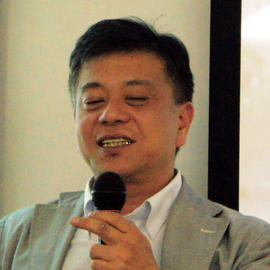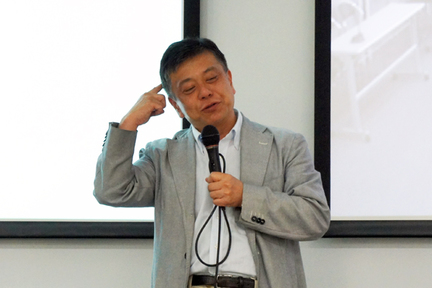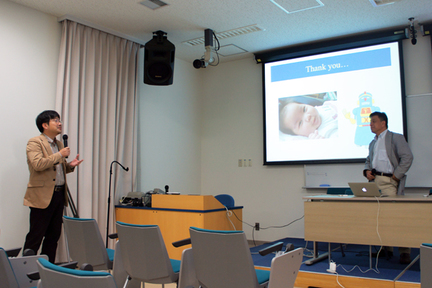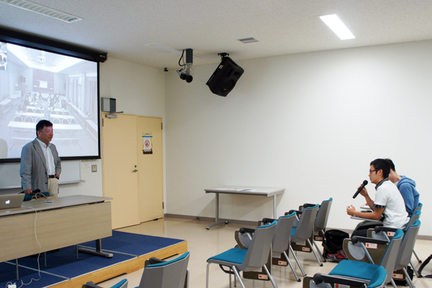I Want to Learn How to Think Beyond Academic Disciplines
Vol.3 2012.10.24 HIRAKI, Kazuo
Developmental Transitions of the Brain and the Mind – Transitions of Self-Recognition
In resent years, research on the links between the developmental transformation of the mind and the brain – Developmental Cognitive Neuroscience – has been rapidly growing. Among numerous researches that exist, our research focuses on the cognitive transitions of the self (and the other). As an empirical scientific indicator of self recognition, mirror images of the self are commonly employed. Mirror-images of the self have several characteristics. One of them is the recognition of “simultaneity” in which movements of the self are reflected in the image in the mirror simultaneously. When the self is motionless, the image in the mirror does not move. It is certain that such a characteristic of the mirror image forms the basis of the self's recognition of its image in the mirror. In the lecture, we will attend to the simultaneity and discuss the issue of the “developmental transitions of the self” by looking at our research conducted on individuals from infants to adults.
- Instructor
-

- HIRAKI, Kazuo
- Professor at the Department of General Systems Studies in Graduate School of Arts and Sciences, the University of Tokyo. Member of the Science Council of Japan. Executive Director of the Japanese Society of Baby Science. Executive Director of the Japanese Society of Child Science. He finished the Doctoral Program at the Graduate School of Keio University. Ph.D. in Engineering. He has gained international and domestic recognition for his empirical research on Baby Science and Developmental Cognitive Neuroscience. He has also been providing information for the benefit of childcare through open lectures, talks, as well as assisting the production of educational TV programs. His major publications include: Mysteries and Wonders of Baby and Sunday Piaget: An Invitation to Baby Science (both are published from Iwanami Shoten).
comments(最新2件 / 3)
- 2012年10月27日 10:44 reply
幼児期の発達(変容)についての研究は非常に興味を持てました。自己同一性というのがいったいいつにおいて確立されていくのかは、長らく謎だったと思います。むしろ注目すべきは人間が他者に対してこそ大いなる関心を抱いていることにこそあると思います。人間は他者によって自らの存在を規定していく。一人では生きていけないというのは、一人では自分の輪郭すら保てないからだと思います。人間は自分を包むものによって自己を自覚している。タイムラグによる実験は、自分のアクションに対して反応するものが、自分にとって重要であることを幼児ですら理解している証拠と言えます。ある意味、人間は死ぬまで幼児期のありかたを引きずっていくものなのかもしれないと思いました。
- 2012年10月29日 07:22 reply
講義ありがとうございました。幼児の発達から変容というテーマに迫る内容は面白かったです。惜しむらくは、心理の授業内容と被るところがあり知っていた部分が多かれ少なかれあったことでしょうか。もちろん復習になってよかったのですが。
鏡やビデオに映る自分を自分と認識できない状態から自分を把握できるようになるのはいつか、また時間認識モジュールの有無を調べる実験などを見るに、自分が乳幼児になって内観することができないことである以上、観察に留まりそこから一般的な解を「見出して」いくことしかできないことに限界を感じました。
一つ疑念、というか表現上しっくりこなかったものとして、発達を変容と捉えてよいものだろうか、というものがあります。姿や形(容)が変わるという意味では確かに発達も変容ですが、常に一方向へ「成長」するのが発達である一方で変容はあらゆる方向に向けられていると思われるので、幼児における変容というのは外界へ新しく開かれた意識、と捉えることにより本講義が変容というテーマにより近づくのでは、と考えもしました。
Post a Comment
- Other Lessons



私達が常識的に想定している自己のかたち、それが人間の発生段階で「変容」しているというお話は非常に刺激的で、かつそれが科学的アプローチによって明らかにされるというのは、不可視の自己に近づくという学問の根本的な要請に積極的な姿勢に思えました。物理的にはタイムラグが発生するはずの知覚が脳によって処理され、一つに統合されるという仕組みは、それ自体が現在時に生きる人間、あるいは生命というものの本質ではないでしょうか。幼児から大人になるにつれて「今」の時間が広がっていくというお話を聞いて、感覚として生じる(作られる)一つの時間の獲得、「今」の保持こそが人間の自意識を形成しているのだろうかと、そんなことを思いました。